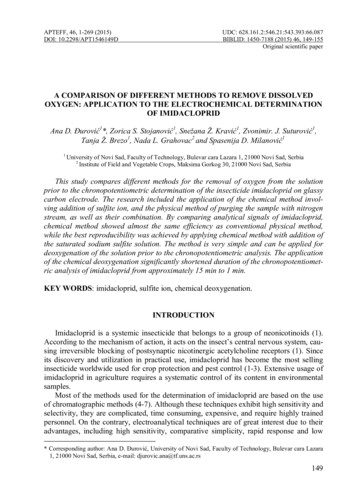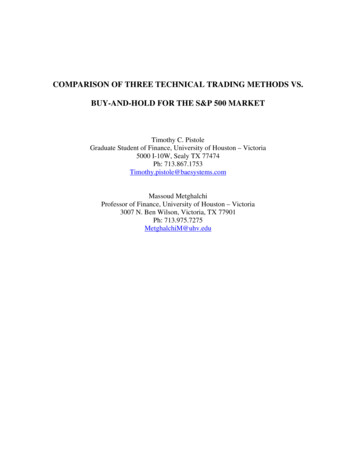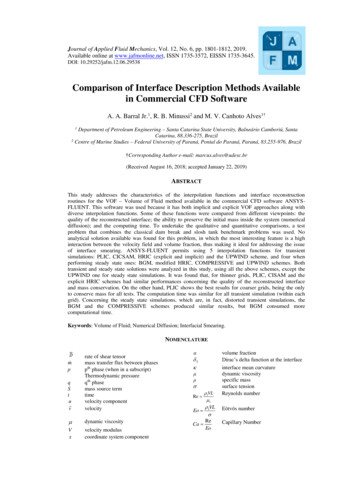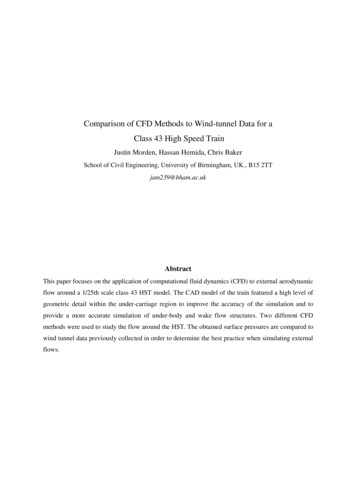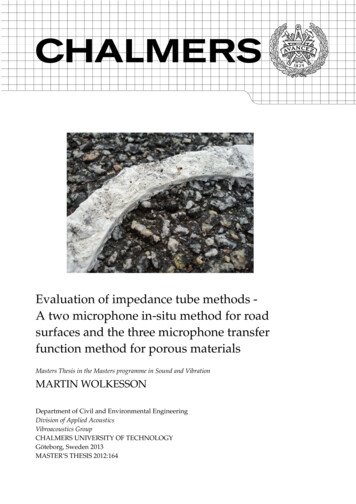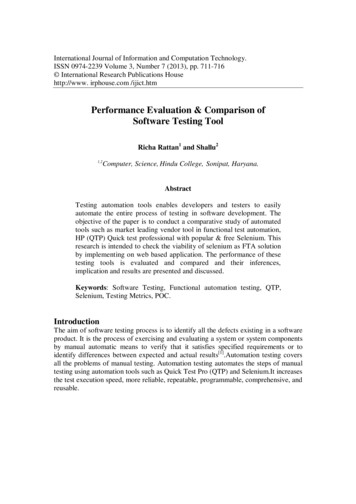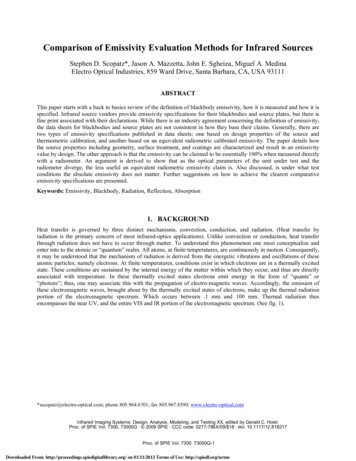
Transcription
Comparison of Emissivity Evaluation Methods for Infrared SourcesStephen D. Scopatz*, Jason A. Mazzetta, John E. Sgheiza, Miguel A. MedinaElectro Optical Industries, 859 Ward Drive, Santa Barbara, CA, USA 93111ABSTRACTThis paper starts with a back to basics review of the definition of blackbody emissivity, how it is measured and how it isspecified. Infrared source vendors provide emissivity specifications for their blackbodies and source plates, but there isfine print associated with their declarations. While there is an industry agreement concerning the definition of emissivity,the data sheets for blackbodies and source plates are not consistent in how they base their claims. Generally, there aretwo types of emissivity specifications published in data sheets; one based on design properties of the source andthermometric calibration, and another based on an equivalent radiometric calibrated emissivity. The paper details howthe source properties including geometry, surface treatment, and coatings are characterized and result in an emissivityvalue by design. The other approach is that the emissivity can be claimed to be essentially 100% when measured directlywith a radiometer. An argument is derived to show that as the optical parameters of the unit under test and theradiometer diverge, the less useful an equivalent radiometric emissivity claim is. Also discussed, is under what testconditions the absolute emissivity does not matter. Further suggestions on how to achieve the clearest comparativeemissivity specifications are presented.Keywords: Emissivity, Blackbody, Radiation, Reflection, Absorption1. BACKGROUNDHeat transfer is governed by three distinct mechanisms, convection, conduction, and radiation. (Heat transfer byradiation is the primary concern of most infrared-optics applications). Unlike convection or conduction, heat transferthrough radiation does not have to occur through matter. To understand this phenomenon one must conceptualize andenter into to the atomic or “quantum” realm. All atoms, at finite temperatures, are continuously in motion. Consequently,it may be understood that the mechanism of radiation is derived from the energetic vibrations and oscillations of theseatomic particles; namely electrons. At finite temperatures, conditions exist in which electrons are in a thermally excitedstate. These conditions are sustained by the internal energy of the matter within which they occur, and thus are directlyassociated with temperature. In these thermally excited states electrons emit energy in the form of “quanta” or“photons”; thus, one may associate this with the propagation of electro-magnetic waves. Accordingly, the emission ofthese electromagnetic waves, brought about by the thermally excited states of electrons, make up the thermal radiationportion of the electromagnetic spectrum. Which occurs between .1 mm and 100 mm. Thermal radiation thusencompasses the near UV, and the entire VIS and IR portion of the electromagnetic spectrum. (See fig. 1).*sscopatz@electro-optical.com; phone 805.964.6701; fax 805.967.8590; www.electro-optical.comInfrared Imaging Systems: Design, Analysis, Modeling, and Testing XX, edited by Gerald C. HolstProc. of SPIE Vol. 7300, 73000Q · 2009 SPIE · CCC code: 0277-786X/09/ 18 · doi: 10.1117/12.818217Proc. of SPIE Vol. 7300 73000Q-1Downloaded From: http://proceedings.spiedigitallibrary.org/ on 01/11/2013 Terms of Use: http://spiedl.org/terms
X RaysThermal -510-410-310-210-1.71101( m)102103104105106Visible.40.48.56.64.70Figure 1. A portion of the electromagnetic spectrum, from gamma rays on the small wavelength end to microwaves on the longwavelength end. Thermal radiation encompasses some of the ultraviolet portion of the spectrum and all of the visible and infraredportions of the spectrum.Thermal radiation propagates from a radiating surface in all possible directions and is emitted over a range ofwavelengths. Thus, the magnitude of emitted radiation must be described such that it is defined both by its wavelengthand its direction; its spectral and its directional components, respectively. Consequently, the ability to describe thedirectional and spectral distribution of radiation is desirable. As a result, radiative terms are used to treat thesecomponents. Spectral intensity ,e , is defined as the rate of radiation energy, at a specific wavelength , per unit area, ina direction normal to that area, per unit solid angle about that direction, per unit wavelength. (See fig. 2) The spectralintensity has units of (W/m2*sr* m) and is given by Equation 1.IIdAdA1I?LV,e( , , )dqdA cos( )d dFigure 2. Solid Angle DiagramProc. of SPIE Vol. 7300 73000Q-2Downloaded From: http://proceedings.spiedigitallibrary.org/ on 01/11/2013 Terms of Use: http://spiedl.org/terms(1)
Alternatively, spectral emissive power , is defined as the rate of radiation energy, at a wavelengthdirections), per unit area, per unit wavelength; and is in units of (W/m2* m) and is given by Equation 2.2( )/2,e0( , , ) cos( ) sin( )d d(emitted in all(2)0It should be noted that is the energy flux based on the surface area of the actual radiating surface while ,e is theenergy flux through a projected area. It is also necessary to account for incident radiation on a surface due to emissionand reflection of radiation from other surfaces. The incident radiation from all surfaces is defined as the irradiation ( );is the rate of radiation energy at a wavelength that is incident on a surface, per unit area, per unit wavelength. It hasunits of (W/m2* m) and is given by Equation 3.2( )/2,i0( , , ) cos( ) sin( )d d(3)0Finally, the radiosity can be introduced ( ). The radiosity is similar in definition to the emissive power but also accountsfor irradiation. As a result is associated with the radiant energy from both direct emission and reflection and is thusdefined as the radiant energy, at a wavelength , (in all directions), per unit area, per unit wavelength. It has units of(W/m2* m) and is given by equation 4. (Note, the subscript “e r” refers to the total intensity due to both emission andreflection, respectively).2( )/2,e r0( , , ) cos( ) sin( )d d(4)0In order to connect these terms and their associations with real surfaces, they must relate to something of theoreticalmeasure. This relation of course is the concept of a Blackbody. A Blackbody is a theoretical object that is both theperfect emitter and absorber of radiation; it is an ideal surface. The characteristics of a blackbody are as follows:A blackbody absorbs all incident radiation independent of wavelength and direction.For a given wavelength and finite, non-zero temperature, no object can emit more energy than a blackbody atthe same temperature.A blackbody is a diffuse emitter.The Planck Distribution estimates a blackbody; where the spectral intensity of a blackbody at a given temperature is ofthe form of Equation 5.2,b( ,T )52hc[exp(hc / kT ) 1](5)and the spectral emissive power is of the form of Equation 6.,b,b( ,T )252 hc[exp(hc / kT ) 1](6)Wien’s displacement law prescribes a peak wavelength to a given temperature, and is given by Equation 7.maxCT3Where C3 2897.8 m*KProc. of SPIE Vol. 7300 73000Q-3Downloaded From: http://proceedings.spiedigitallibrary.org/ on 01/11/2013 Terms of Use: http://spiedl.org/terms(7)
For example, the sun, which can be approximated as a blackbody at 5800 K, has a max spectral distribution at about .5m using Wien’s displacement law. (See Fig.2) This peak spectral distribution is in the visible spectrum. Alternatively, ablackbody at 1450 K, would have a max spectral distribution at about 2.0 m; corresponding to short wavelength IRportion of the electro-magnetic spectrum and is thus, invisible to the naked eye. Accordingly, the peak spectraldistributions of blackbodies with temperatures significantly lower than 5800 K, are not visible to the naked eye.Planck Dlaekbody placement2000K10I01001 0'10'10'Wavelength (micrometers)Figure 2: LogLog plot of the spectral distribution of blackbodies at various temperatures. (Spectral emissive power vs. wavelength).Wien’s Displacement Law prescribes a max wavelength corresponding to a max spectral emissive power.The total emissive power of a blackbody may be found using the Stefan-Boltzmann law. The Stefan-Boltzmann lawexpresses the total emissive power of a blackbody by Equation 8.b05C1d[exp(C 2 / T ) 1]T4Where C1 3.742x108 W* m4/m2 and C2 1.439x104 m*KWith all the previous concepts understood, blackbody phenomenon may now be introduced.Proc. of SPIE Vol. 7300 73000Q-4Downloaded From: http://proceedings.spiedigitallibrary.org/ on 01/11/2013 Terms of Use: http://spiedl.org/terms(8)
2. INTRODUCTIONThe ideal surface, known as a blackbody, is both the perfect absorber and emitter of radiation. Any real body can neveremit or absorb more energy than a blackbody at the same temperature. However, it is convenient to analyze real surfacesin reference to blackbodies. Thus, any real radiating surface can be considered by the dimensionless parameter, , knownas the emissivity; which may be defined as the ratio of the radiation emitted by a real surface to that radiated by ablackbody at the same temperature. The total emissivity, that is the emissivity averaged over all wavelengths and in ahemispherical direction, is given by the total emissive power of the real surface at a given temperature over the totalemissive power of a blackbody at the same temperature, see Equation 9.(T )(T )(T )(T )T(9)4bIt is however important to realize that spectral radiation by a real surface differs from the Planck Distribution andadditionally, is not necessarily diffuse. For instance, a real surface may have a preferential distribution of radiation incertain directions or wavelengths. Therefore, analogous wavelength dependent and directional dependent emissivities areconsidered. The spectral directional emissivity is thus the ratio of the intensity of the energy radiated by a surface at awavelength in the direction, over the intensity of the energy radiated by a blackbody at the same temperature andwavelength. The spectral directional emissivity is given by Equation 10.,( , , ,T ),e( , , ,T )( ,T )(10),bHence, the total directional emissivity is defined as the ratio of the spectral average of the intensity of the radiationemitted by a surface in the direction, over the intensity of the radiation emitted by a blackbody at the sametemperature and is given by Equation 11.( , ,T )e( , ,T )(T )(11)bConversely, the spectral hemispherical emissivity is defined as the ratio of the radiation emitted by a surface at aparticular wavelength in a hemispherical direction, over the radiation of a blackbody at the same temperature andwavelength; (the ratio of the spectral emissive power of a surface at wavelength over the spectral emissive power of ablackbody at wavelength ). The spectral hemispherical emissivity is given by Equation 12.( ,T )( ,T )( ,T )(12),bAs a result, absorptivity, transmissivity, and reflectivity are defined by the ratio of irradiation absorbed by a surface tothe total irradiation, the ratio of irradiation transmitted through the surface to the total irradiation, and the ratio of theirradiation reflected by the surface to the total irradiation, respectively. Absorptivity, transmissivity, and reflectivity aredenoted by , , , respectively and are related by equation 13.(13)1For opaque surfaces, the transmissivity term goes away.Proc. of SPIE Vol. 7300 73000Q-5Downloaded From: http://proceedings.spiedigitallibrary.org/ on 01/11/2013 Terms of Use: http://spiedl.org/terms
In an isothermal enclosure, that is, an enclosure at a uniform and constant temperature, (i.e. at equilibrium), there is zeronet exchange of radiation. That is for any surface inside the enclosure the radiation in equals the radiation out; there is noaccumulation of energy. (See Fig 3) This may be shown by a simple energy balance given by Equation 14.A111(14)0(T s ) A1TsA1A2A3Figure 3: Exchange of radiation in 3 small surfaces within an isothermal enclosure.Equation 14 states that the amount of radiation absorbed is equal to the radiation that is emitted out. Under these sameconditions any body that lies within the enclosure must be diffuse, and thus the irradiance is equal to the emissive powerof a blackbody at the same temperature of the isothermal cavity. Therefore by combining the previous statement withEquation 14 the following is derived.b(T )1sb(T ) As111(T ) A 0s(T )sb1(T )1sWhich yields Equation 15 for any body inside the isothermal enclosure, which is otherwise known as Kirchhoff’s Lawand also proves that no body can emit or absorb more radiation than a blackbody.1(T s )2 (T s )123 (T s )3b (T s )(15)This enclosure is therefore consistent with the concept of a blackbody cavity. Thus, Kirchhoff’s Law alternatively statesthat the absorptivity equals emissivity inside of a blackbody cavity, equation 16.123123(16)1This is also true for directional and wavelength dependent forms of the emissivity and absorptivity, (i.e. the spectral,hemispherical emissivity equals the spectral, hemispherical absorptivity).Proc. of SPIE Vol. 7300 73000Q-6Downloaded From: http://proceedings.spiedigitallibrary.org/ on 01/11/2013 Terms of Use: http://spiedl.org/terms
3. SPECIFYING EMISSIVITY OF COMMERCIAL BLACKBODIESIn the commercial market there are blackbodies available in a number of configurations. Technically, all of thecommercial blackbodies are “graybodies” since their emissivity is less than one, in industry this distinction is rarelyapplied and these products are referred to generically as blackbodies; just as Klennex is used for tissues. So for theremainder of this paper the term blackbody will be used instead of the strictly correct term of graybody.The geometry of the blackbody can produce higher emissivity but at a cost. In the preliminary discussion, the equationsapply to a surface at a specific temperature. In the world of commercial blackbodies, the most common geometries arecavities and plates.Radiation emitted from a source plate follows the equations to the first order. The reflectance and absorbance of thesource plate is determined by its surface treatment. The coating applied to the surface greatly enhances the emissivity.Unfortunately for the predictability of the radiance from the surface the coating behavior is not always ideal.10.98Emissivity0.960.940.920.9310.3 C0.88501.2 C0.86234567891011121314151617181920Wavelength (microns)Figure 4: Spectral emissivity of standard sampleFigure 4 is the spectral emissivity of a sample coupon coated with a high temperature material. This data is taken with ahemispherical reflectometer. The real world performance shows that the emissivity of the coating on a specific surface isnot uniform with respect to wavelength and temperature. In this particular example the emissivity performance in theMWIR is several percentage points higher than in the LWIR. There is considerably lower emissivity near roomtemperature than when the sample is heated.Knowledge of the coating performance properties can allow the customer to calculate the expected output from a sourceplate for a given wavelength range. Using a single emissivity value will lead to small errors in expected radiance.There are surface treatments that improve the emissivity of the source plate even using the same coating. See Figure 5for an emissivity scan of an enhanced surface treatment.Proc. of SPIE Vol. 7300 73000Q-7Downloaded From: http://proceedings.spiedigitallibrary.org/ on 01/11/2013 Terms of Use: http://spiedl.org/terms
10.98Emissivity0.960.94303 C0.92580.4 th (microns)Figure 5: Spectral emissivity of enhanced sampleUsing this information convolved with the radiance equations will give a good prediction of radiance output of the plateverses temperature. In this case the temperature of the plate is precisely calibrated using commercially available, NISTtraceable temperature measurement equipment.A radiometric calibration of the source place can be done by comparing the output of the plate to a “known” primarystandard. There are several additional sources of error that come with the radiometric calibration. The wavelength rangeof sensitivity of the calibration device must match the spectral sensitivity of the UUT that will be used with thisblackbody. Otherwise, one could see that if the radiometric calibration was done with a detector that is active 8-12 mrange but the UUT is sensitive in the 3-5 m range; there will be skewed result.The other major geometry of blackbodies is cavities. Cavities essentially force the majority of the photons emitted fromthe surface to bounce off other surfaces within the cavity before the photon finds its way out of the cavity. Thisrandomization improves the uniformity but at the same time creates a directed beam of photons instead of fullLambertian output. Common cavity shapes are cylindrical, conical and spherical. The emissivity of a cavity blackbody isa combination of its geometry and surface treatment.The relative emissivity that comes from the geometry is ranked from cylindrical, conical, spherical and is highest with areverse conical design. The calculations to support this assertion are covered in “Chandos and Chandos” and “TheInfrared Handbook”. As Table 1 shows, even with a nominal coating emissivity of 0.8, a conical cavity will achieveemissivity greater than 0.97.Proc. of SPIE Vol. 7300 73000Q-8Downloaded From: http://proceedings.spiedigitallibrary.org/ on 01/11/2013 Terms of Use: http://spiedl.org/terms
Table 1: Geometric emissivity enhancement summaryCavity TypeEffective Emissivity- (eff) with0.7 coating0.8 coating0.9 coatingCylindrical (L/R 8)0.99460.99660.9984Conical (14 99Spherical (Ac/4R s2 0.9)Reverse Conical (14 )An example of a conical cavity is in Figure 6. The radiant output of a 1 inch (25.4 mm) diameter cavity diverges in acone of 11 ; 0.2 steradian, instead of the 2 steradian solid angle from the source plate. Typically, the cavity is used touniformly illuminate a target close to exit of the cavity. This target is usually positioned at the focal point of an opticalcollimator to project an image of the target at a specific temperature. The other way the target is used is to focus theUUT on the target.,, , ,,,,,,,,,,,,,,, ,,,,,,,,,,Cylindrical CavityConical CavitySpherical CavityReverse Conical CavityFigure 6: Typical cavity type blackbody geometriesAs in the case of the source plates, the emissivity of the surface or surface coating changes with spectrum andtemperature. In this case, as long as the emissivity of the surface is nominally the same, it is a small effect compared tothe geometry. So the effects due to the properties of the spectral variation of surface emissivity do not have to becalculated beyond the first order to determine the emissivity of a cavity.Proc. of SPIE Vol. 7300 73000Q-9Downloaded From: http://proceedings.spiedigitallibrary.org/ on 01/11/2013 Terms of Use: http://spiedl.org/terms
There are two ways to calibrate cavity blackbodies. One can measure the temperature of the surface with a contactthermocouple. Using this method the output of the cavity can be calculated using Plank’s equation. Using a radiometricmethod introduces other potential sources of error. Because a cavity blackbody emits in a limited cone angle, there is apossibility of the detector’s FOV not matching the UUT’s FOV. In the uniformity example below (Fig. 7), you can seethat the uniform cone of this cavity is limited to 2 degrees, many radiometers have a wider field of view than this;allowing the radiometer to include some cooler temperature signals from the edges and the background. If the detectorused for radiometric calibration of the blackbody does not have the same optical
The radiosity is similar in definition to the emissive power but also accounts for irradiation. As a result 5 is associated with the radiant energy from both direct emission and reflection and 5O is thus defined as the radiant energ

